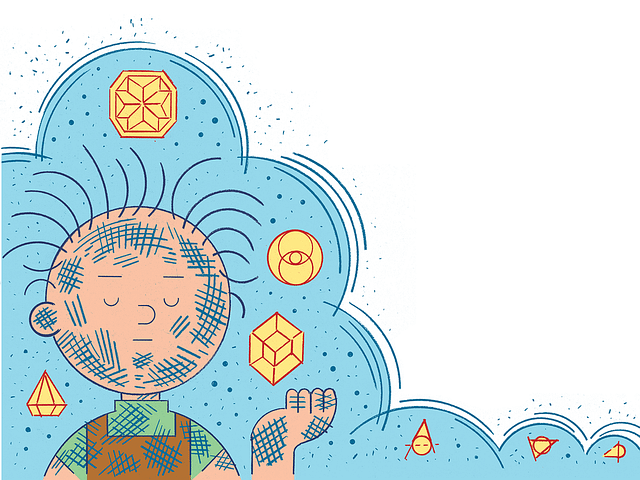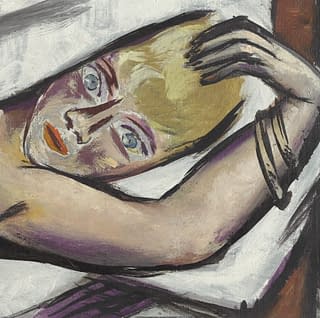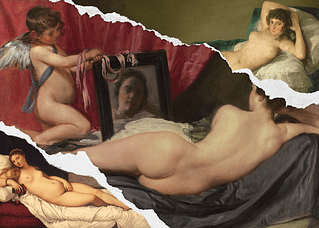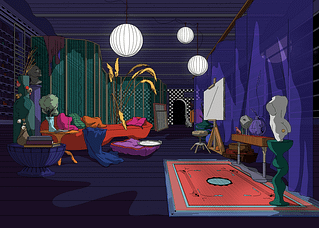
I first encountered the Peanuts strips around age six, when my father started taking me with him to the used bookstore. This was the eighties, so the used books were from the sixties and seventies. I naturally gravitated to the pocket paperbacks: small, densely printed volumes with titles like Games People Play, The Art of Loving, and When Bad Things Happen to Good People that projected an air of containing real solutions to the real problems that a real person might have, without being actually readable. Hidden among those books were books of identical dimensions, printed on the same kind of newsprint, with a lot of inky text on every page — books that looked, in other words, exactly the same as actual books and not like some fake, debased version that had been invented to placate and deceive children — and yet contained pictures of Snoopy. The books were not “about” Snoopy, as children’s books would have been. Rather, they represented a world to which Snoopy, in some ambiguous, shifting capacity, belonged. Those were the books from which I learned about the games people played, the art of loving, the relationship between bad things and good people — the way the bad things wore the good people down and made them self-absorbed.
At first glance, the world of Peanuts was a highly legible one, populated by clearly labeled types. And yet the labels kept leading into uncertainty. Snoopy, for example, was “a beagle.” He also read War and Peace and owned a typewriter. Lucy was a “fussbudget”: she was one always, in some essential way. But what was it about her that was “fussbudget”? Was there a fussbudgetness in all her words and actions or only in some of them? With Pig-Pen, it was somehow even more fundamental. Pig-Pen was dirty — visibly so. His character was scribbled over, shaded, covered with specks. He was, in the sense of a child’s drawing, “messed up,” “a mess.” That’s who and how he was. And yet — what was that dirtiness? Was it essential or incidental? How did it work?
Readers’ love of Pig-Pen was reportedly a burden to Charles M. Schulz. Much as Arthur Conan Doyle attempted to kill off Sherlock Holmes in 1893 only to bring him back nine years later, so did Schultz write Pig-Pen out of the series from 1967 to 1976. Pig-Pen himself is not uninfluenced by Conan Doyle: he is, in essence, a walking clue. “I can tell just where you’ve been all week from the dirt on your clothes,” Charlie Brown tells a consternated Pig-Pen in August 1965, proceeding to rattle off a series of dusty locations.
In 2007, Ballantine Books put out a slim volume called The Dirt on Pig Pen, comprising the hundred or so strips in which Pig-Pen appears (out of a total of 17,897) between 1954 and 1999. Reacquainting myself with Pig-Pen’s exploits in chronological order, I easily saw what it was that had confused me as a child. There is something hard to pin down in Pig-Pen’s condition. The nature, even the physical behavior of Pig-Pen’s dirt fluctuates. From one week to another, it is likened to chalk powder (as when he “washes” his hands by beating them together, “the way they clean erasers”), to sand (you could put “four boards around that kid and have an ‘instant sandbox’”), to soil, mud, and dust. He is described as being “cooled by several layers of clay” (protecting him from heat), or blending in with the dirt at second base. He is associated with bacteria, carrying his Easter jelly beans around so long that they start to “ferment.” Violet describes him as a “germ carrier.” Pig-Pen seems offended, but declares that even germs need a rest. The physical dirt itself: Is it organic or inorganic? Does it come off? Does Pig-Pen want it to?
Pig-Pen first appears in 1954. Violet’s judgmental friend, Patty, sees him playing in the sand and asks his name. Pig-Pen replies that he doesn’t have one; people just call him “insulting things.” Patty asks for specifics. “I’ll tell you if you won’t laugh,” Pig-Pen says. His name is a punch line. For a long time, Pig-Pen’s name consistently appears in quotation marks, reminding us that it isn’t really a name — that he has, presumably, another one that he doesn’t know. From 1980 to 1997, the quotation marks disappear, blurring the line between Pig-Pen’s “true self” and a reductive description directed at him by other people, which is in effect what a name comes down to.
In a way, Pig-Pen seems to be conjured by Patty herself. Patty, with her grid-patterned dress and matching bow, is the most concerned with propriety, appearances, and conventions. She is a kind of emanation of the fifties. (Once sandal-wearing Peppermint Patty, who isn’t overconcerned with neatness, appears in 1966, the other Patty is no longer mentioned by name and soon essentially disappears from the strip.) Pig-Pen, then, may be Patty’s Jungian shadow, the dark side of the fifties suburban ideal. In 1956, Charlie Brown describes Pig-Pen as “the only person I know who can raise a cloud of dust on a clean sidewalk.” It’s a subtly disorienting moment.
If the sidewalk was clean… where did the dust come from? Did Pig-Pen generate it? Did he know how to draw it out of his environment? Also in 1956, Pig-Pen is described as “a human Soil Bank.” Part of the Agricultural Act of 1956, the Soil Bank incentivized farmers, threatened by drought and a manufacturing boom, to remove farmland from production. In another fifties strip, Charlie Brown calls Pig-Pen a “human Dust Bowl,” alluding to the farming crisis of the Depression. Pig-Pen heralds the end of the “dream” that the rich soil of America could literally make a person rich. Patty and Violet loudly proclaim Pig-Pen’s unmarriageability, and when Pig-Pen protests — in fact, he is a catch, both “a husband and an acre of good topsoil!” — Patty and Violet aren’t impressed.
The setup of one particularly dark strip from 1955 consists of the other children laughing at Pig-Pen, with the punch line, “Someday I’ll be a ‘white-collar worker’!” Pig-Pen here conjures the dark side of the system of class. Pig-Pen is the one whose function is to be lower than the others, ensuring the smooth running of society (a function Pig-Pen occasionally trades with Charlie Brown). A recurring Pig-Pen joke is that Snoopy — inhabiting, in these interactions, the role of “the dog” — has more status than he does. Pig-Pen hugs Snoopy, calls him a nice doggy, tries to feed him the blackened gumdrops from his pocket. Pig-Pen patronizes him, believing he occupies a higher point in the social hierarchy. But he is wrong. Snoopy is appalled by the handprint Pig-Pen leaves on his head; he won’t touch Pig-Pen’s debased candy.
In the 1954 strips, Schultz establishes the basic rules of Pig-Pen’s dirtiness. Pig-Pen doesn’t dislike baths; he just prefers getting dirty. He doesn’t try to get dirty; he just doesn’t go out of his way to stay clean. Dirtiness, if not precisely an elected state, is one Pig-Pen can initially control — sometimes to fantastical precision. At one point he tricks Patty into leaving him alone by seeming to have washed his face; when she walks away, we see that the other half of his face is dirty.
Over the course of a month in 1954, Pig-Pen’s dirtiness spreads to the other characters: first Schroeder, then Snoopy. Patty is shown talking into a telephone about the “awful” contagion; the person on the other end of the phone is ultimately revealed to be… Dirty Charlie Brown. (“What’s so awful about it?”) Everyone, it turns out, has a Dirty version of themselves: mussed, unkempt, scribbled over. This feels true. The contagion plotline ends when Schroeder and Charlie Brown, now clean, call Patty to tell her they followed her advice. (“You’d really be proud of us.”) Cut to the person at the other end of the phone… Dirty Patty. (“I would?”) Patty and Pig-Pen, the self and its shadow, have finally merged. The contagion series came out in September 1954, as Joseph McCarthy was finally being discredited after four years of the Red Scare.
It’s clear that the contagion is a social one: under Pig-Pen’s influence, the children decide to be dirty. When they decide to be clean again, they are. On the whole, being dirty is a decision people make — though it isn’t quite so simple.
Starting in 1955, there are moments when Pig-Pen physically can’t get clean, despite his efforts. In June, Pig-Pen scrubs and scrubs his hands, but they remain dirty: he has reached the long-feared “point of no return.” When Pig-Pen plays in the snow, instead of getting less dirty, he ends up building “the world’s dirtiest snowman.” Pig-Pen’s dirtiness becomes a force of nature, more powerful than the whiteness of snow. “As the duck is drawn to the pond, and as the rabbit is drawn to the briar patch,” Pig-Pen announces in a later panel, “so am I drawn to the mud puddle!” Dirtiness is an ineluctable state, a natural state — one to which Pig-Pen may be drawn even despite his wishes. When Charlie Brown attempts to separate nature from nurture — “Do you suppose it’s hereditary, or is it your environment?” — Pig-Pen only muddies the question: “It must be my environment… I’m covered with it!”
In 1956 we first encounter the motif of Venerable Pig-Pen, the bearer of venerable history. “I have affixed to me the dirt and dust of countless ages,” he remarks at one point, adding, “Who am I to disturb history?” Pig-Pen’s dirt becomes a site of absurdism and unknowability, a running Zen koan. In 1958, he pauses to shake some grit from his shoe, and out falls a mound of sand as big as he is. In 1959, when Patty asks how Pig-Pen manages to get so dirty, Pig-Pen replies, “I guess there are some things we will never know in this lifetime!” Pig-Pen begins to take a philosophical attitude toward his inability to get clean: he has learned “never to expect too much from a shower” — to be “satisfied if it just settles the dust.”
Pig-Pen continues to appear regularly in the early sixties but soon fades out and disappears for almost the whole seventies, returning in sustained form only in the eighties. Perhaps the more explicitly “messy” sixties and seventies don’t need Pig-Pen to expose their dark underside. Pig-Pen flourishes in the self-satisfied decades: the fifties, the eighties, and the nineties.
The apotheosis of the Pig-Pen storyline takes place in the late eighties, when he goes into analysis with Lucy. That’s when the contradictions finally make sense. Pig-Pen’s dirtiness only seemed to be physical. It is psychological: a feature of his character and his fate, an expression of how the two determine each other.
The therapeutic dialogue between Pig-Pen and Lucy has a poignancy only hinted at earlier — for example, when Pig-Pen asks, “How would you like to go through life being called ‘Pig-Pen’?” It’s a question that has been latent since his first appearance. To what extent is Pig-Pen actually Pig-Pen? To what extent has he been made Pig-Pen by others? Lucy, who isn’t the best therapist but also isn’t the worst, asks what Pig-Pen’s father was called. “Pig-Pen Senior,” Pig-Pen replies, encapsulating the problem of individual and family destiny.
A particularly jarring and revealing moment is when Lucy asks Pig-Pen what would happen if he tried to start going “just one hour without getting dirty.” “Do you have any idea how painful a migraine can be?” Pig-Pen replies. It feels like a new register — like a direct, honest statement about addiction. It makes us reframe personality itself in terms of addiction. Tragically, Lucy can’t or won’t rise to the challenge. What she wants isn’t to understand Pig-Pen’s dirtiness but to cure it. For this reason, the therapy is doomed. “When I look at you, all I see is dirt and dust,” Lucy says. “You don’t need a psychiatrist… You need an archaeologist!”
As I contemplate The Dirt on Pig Pen, it occurs to me that the Peanuts strips may have been my first novels. They weren’t, of course, novels, but because I consumed them not in small installments in a newspaper but for hours at a time in book form, I had to make novelistic extrapolations — I had to find a way to reconcile the contradictions from week to week. And those contradictions are the same ones we find in great novels. There’s something Dostoyevskian about Pig-Pen’s identification with the “insulting things” people say, his pride and perversity in doing the thing that makes him be insulted, and the abiding question of whether it is in fact possible for him to act otherwise. Reading every Pig-Pen strip in chronological order forces us to face the same challenges we face in defining any “character” over time: to separate the incidental from the inherent, the voluntary from the inborn; to tease apart the effects of upbringing and personal appearance — to try, in short, to solve what critics of the novel call “the problem of the person.” The Dirt on Pig Pen is nothing less than the enigma of human personality. If it is true that Pig-Pen needs, as Lucy says, “an archaeologist,” it is because the answer to his character can come not from resolving the contradictions but only from seeing them all at once.


